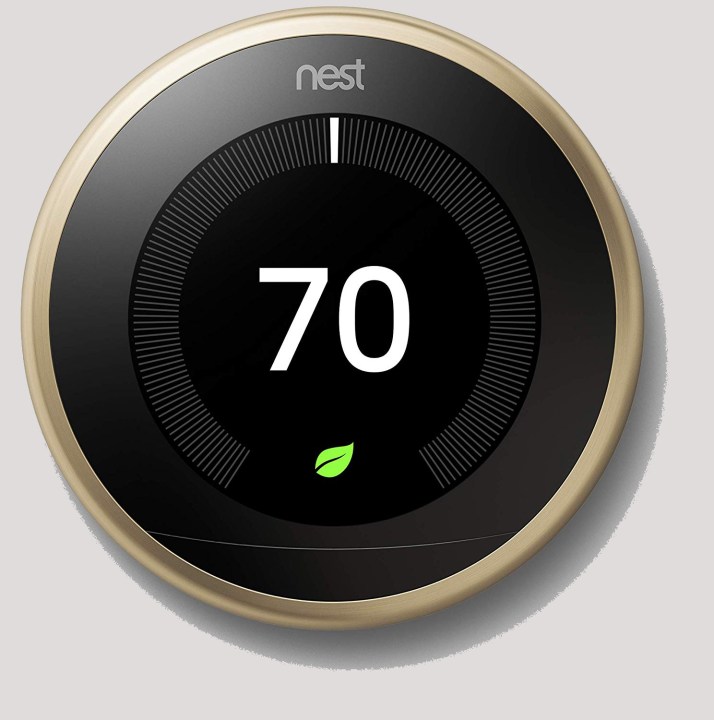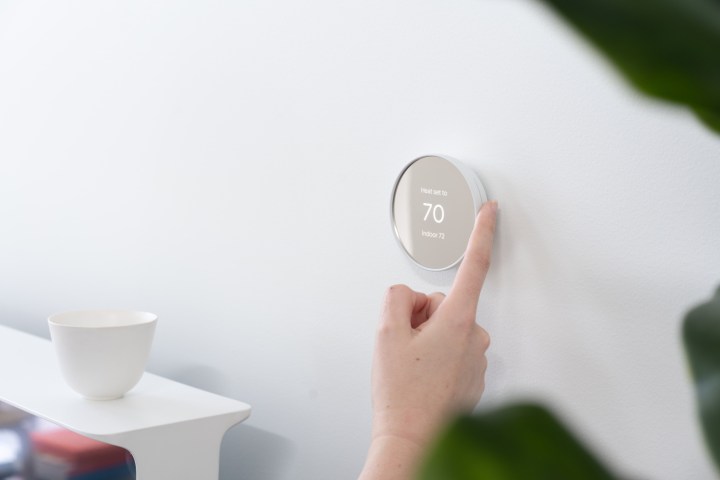When it comes to smart thermostats, the Google Nest Learning Thermostat has long reigned supreme. It’s easy to set up, looks sleek, logs your family’s temperature preferences, and automatically regulates your HVAC based on how warm or cold it is in your home. Compatible with up to 95% of most heating and cooling systems, the Nest Learning is a premium thermostat with a top-dollar price of $249.
Going for nearly half the cost of the Nest Learning, the reimagined Google Nest Thermostat is the new kid in town. Gone is the dial of years past in favor of new interactive touch controls and a Pixel 4-inspired mirror display. It’s great if you’re shopping for smart tech on a budget, and it can stand toe to toe with a number of Nest Learning features.
If you’re in the market for a Google-branded thermostat but aren’t sure which Nest product to spring for, we’ve got you covered. This guide pits the latest Nest Thermostat against the flagship Nest Learning model, comparing criteria like design, features, and overall value.
Design

The latest Google Nest Thermostat measures 3.3 inches in diameter, features a plastic housing, and comes in four different colors: Snow, Sand, Fog, and Charcoal. If you’re upgrading from a bulkier thermostat, you can purchase the $15 color-matched trim kit to cover up the holes left by your old model.
One of the biggest changes for the fourth-generation Nest is the loss of the turn-dial. Thermostat adjustments and other menu features are now mapped to a haptic strip on the right side of the Nest. There’s also a brand new display. The previous Nest generation (Nest Thermostat, Thermostat E, and Nest Learning) uses a 24-bit LCD display. While the LCD component remains, a mirrored lens completes the display. Temperature readings and other info shine through the mirror when you interact with the thermostat. When no info is displayed, the mirror functions as… a mirror. This redesign is also backed by the same Soli monitoring technology that Google built into their Pixel 4, which allows the Nest Thermostat to determine when you’re standing in front of it without the need for traditional motion sensors.
The Nest Learning Thermostat maintains the O.G. turn-dial of previous Nest iterations. The thermostat is 3.3 inches in diameter, features a metal housing, and is available in multiple colors, including white, black, copper, polished steel, stainless steel, brass, and Mirror Black.
Features

The fourth-gen Nest Thermostat brings a few new features to the table. For starters, there’s no active temperature monitoring. Instead, you use the Google Home app (more on that below) to create customized schedules for your Nest. You can tell it things like when you’re going to be home, when you’ll be away, and what time of day you’d like the heat to fire up. Through the Google Home app, the latest Nest will send you HVAC system notifications, as well as make suggestions for ways to lower your energy bill. One of our favorite new Nest tricks is brought to you by the thermostat’s Soli monitoring tech and your Google Home app. When you leave your home, the Nest will automatically enter Eco Mode to conserve energy while you’re away.
Unfortunately, the lower price means we lose some things, too. The new Nest is not compatible with Nest Temperature Sensors. There’s also no rechargeable battery (two AAA instead), no included trim plate, and no convenient Farsight display. Available on the third-gen Nest (and Nest Learning), Farsight shows basic info like the time, temperature, and weather, without you having to stand in front of the thermostat to wake it.
In terms of tech, the nearly decade-old Nest Learning Thermostat can still do more. The flagship thermostat actively learns your family’s temperature preferences, can link and interact with additional Nest Temperature Sensors for even better temperature regulation, and is powered by a rechargeable lithium-ion battery.
Both the Nest and Nest Learning are compatible with most major HVAC brands. The new Nest is capable of controlling up to 85% of most heating/cooling setups, while the Nest Learning can control up to 95% of HVAC systems.
Controls

We’ve discussed the manual control elements of both thermostats, but what about their extended capabilities? Of course, both thermostats can still be controlled by your favorite Google Home smart speakers. Amazon households will also be pleased to know that both thermostats are Alexa-compatible, too. Both voice assistants allow you to raise and lower the temperature, cycle between heating and cooling options, and power on/off your HVAC.
In terms of setup and mobile app controls, the standard Nest can be controlled on the go with the Google Home app, Nest app, or both. The Nest Learning Thermostat can only be controlled (and set up) with the Nest app.
Price and warranty
The fourth-gen Nest Thermostat is available to pre-order for $129 and is due to begin shipping in a few weeks. The Nest Learning Thermostat normally sells for $249. The standard Nest comes with a one-year limited warranty, while the Nest Learning comes with two years.
The verdict
If you’re shopping purely based on budget, there’s no doubt that the new Nest Thermostat is your best bet. It’s packed with intelligent features, looks awesome, and is easy to control. It’s also slightly less imposing for those that are upgrading from a basic thermostat. But, if you’re shopping for the best features (and price is no object), the Nest Learning Thermostat is probably the better choice. Google’s flagship thermostat actively learns the best ways to keep your home toasty and cool, can be linked to other Nest Temperature Sensors and keeps the Farsight tech of years past.
The choice is yours. We’re only here to help. Speaking of help, do check out our smart thermostat install guide. Not feeling like Google is the thermo brand for you? Take a look at our roundup of the best smart thermostats overall.


